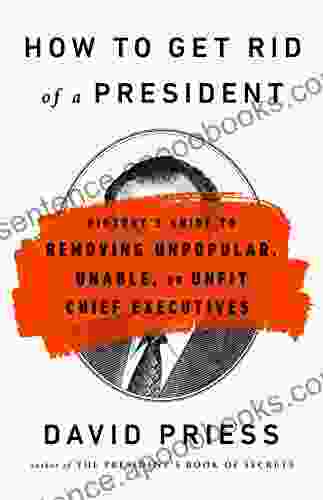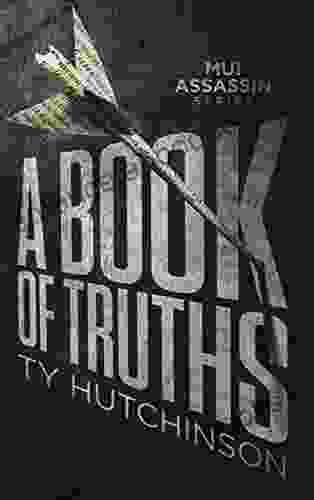Unveiling the Secrets: How to Effectively Dismiss Your President

In the realm of politics, the removal of a sitting president is a complex and often controversial process. However, there are a number of methods that can be employed to achieve this goal, as outlined in the comprehensive guide, "How to Get Rid of President."
4.5 out of 5
| Language | : | English |
| File size | : | 1827 KB |
| Text-to-Speech | : | Enabled |
| Screen Reader | : | Supported |
| Enhanced typesetting | : | Enabled |
| X-Ray | : | Enabled |
| Word Wise | : | Enabled |
| Print length | : | 321 pages |
This article delves into the intricate mechanisms that govern presidential dismissal, exploring legal, political, and historical precedents. By examining the various methods and their potential consequences, it provides a valuable resource for understanding this critical aspect of modern governance.
Legal Avenues for Presidential Removal
Impeachment
Impeachment is the most formal and severe method of removing a president from office. It involves two distinct stages: a vote of impeachment by the House of Representatives and a trial by the Senate. A president can be impeached for "treason, bribery, or other high crimes and misdemeanors."
The impeachment process is highly political and has only been successfully completed twice in American history. Both Andrew Johnson and Bill Clinton were impeached by the House, but were acquitted by the Senate.
25th Amendment
The 25th Amendment to the Constitution provides a mechanism for removing a president who is unable to fulfill the duties of office due to physical or mental incapacity. It allows the Vice President, in consultation with the Cabinet, to declare the president "unable to discharge the powers and duties" of the office.
The president can then contest this declaration, but if two-thirds of both the House and Senate agree with the Vice President's assessment, the president will be removed from office.
Resignation
In some cases, a president may choose to resign from office. This can be a strategic move to avoid impeachment or further controversy, or it can be due to personal or health reasons.
Richard Nixon resigned from office in 1974 in the face of almost certain impeachment and conviction for his role in the Watergate scandal.
Political and Public Pressure
Public Protests and Boycotts
Sustained public pressure can play a significant role in forcing a president to resign or change course. Large-scale protests, boycotts, and other forms of civil disobedience can demonstrate widespread discontent and erode the president's political support.
The anti-war movement during the Vietnam War and the Civil Rights Movement of the 1960s are examples of successful public campaigns that pressured presidents to alter their policies.
Congressional Investigations and Oversight
Congressional committees can launch investigations into presidential conduct and alleged wrongng. These investigations can uncover damning evidence, damage the president's reputation, and erode public confidence.
The Watergate scandal, which led to Nixon's resignation, was uncovered through congressional investigations spearheaded by the House Judiciary Committee.
Historical Precedents
Andrew Johnson (1868)
Andrew Johnson became the first president to be impeached, accused of "high crimes and misdemeanors" for defying Congress's Reconstruction policies. He was acquitted by the Senate by a single vote.
Richard Nixon (1974)
Richard Nixon resigned from office rather than face impeachment over his involvement in the Watergate scandal. The scandal stemmed from an attempt by Nixon's administration to cover up its break-in of the Democratic National Committee headquarters.
Donald Trump (2019)
Donald Trump became the third president to be impeached, accused of abuse of power and obstruction of Congress. He was acquitted by the Senate in both cases.
The process of removing a president from office is a complex and challenging one. There are multiple legal avenues, political strategies, and historical precedents to consider.
Understanding the mechanisms and consequences involved in presidential dismissal is crucial for informed participation in democratic society. The guide, "How to Get Rid of President," provides a comprehensive analysis of this critical aspect of governance, empowering citizens with the knowledge to hold their leaders accountable.
4.5 out of 5
| Language | : | English |
| File size | : | 1827 KB |
| Text-to-Speech | : | Enabled |
| Screen Reader | : | Supported |
| Enhanced typesetting | : | Enabled |
| X-Ray | : | Enabled |
| Word Wise | : | Enabled |
| Print length | : | 321 pages |
Do you want to contribute by writing guest posts on this blog?
Please contact us and send us a resume of previous articles that you have written.
 Book
Book Novel
Novel Page
Page Chapter
Chapter Text
Text Story
Story Genre
Genre Reader
Reader Library
Library Paperback
Paperback E-book
E-book Magazine
Magazine Newspaper
Newspaper Paragraph
Paragraph Sentence
Sentence Bookmark
Bookmark Shelf
Shelf Glossary
Glossary Bibliography
Bibliography Foreword
Foreword Preface
Preface Synopsis
Synopsis Annotation
Annotation Footnote
Footnote Manuscript
Manuscript Scroll
Scroll Codex
Codex Tome
Tome Bestseller
Bestseller Classics
Classics Library card
Library card Narrative
Narrative Biography
Biography Autobiography
Autobiography Memoir
Memoir Reference
Reference Encyclopedia
Encyclopedia Brent Christianson
Brent Christianson Graeme Smith
Graeme Smith Elizabeth Angus
Elizabeth Angus S M Nevermore
S M Nevermore Shelena Shorts
Shelena Shorts Carlos Bautista
Carlos Bautista V R Christensen
V R Christensen Laura Grace Weldon
Laura Grace Weldon Fabiana Volpato
Fabiana Volpato Benjamin H Snyder
Benjamin H Snyder Curt Thompson Md
Curt Thompson Md Mumia Abu Jamal
Mumia Abu Jamal Dodge Billingsley
Dodge Billingsley Anne Moss Rogers
Anne Moss Rogers Alfred S Posamentier
Alfred S Posamentier A Charles Ware
A Charles Ware Elizabeth Lowell
Elizabeth Lowell Eduardo Bonilla Silva
Eduardo Bonilla Silva Joseph F Trimmer
Joseph F Trimmer Tomas Transtromer
Tomas Transtromer
Light bulbAdvertise smarter! Our strategic ad space ensures maximum exposure. Reserve your spot today!

 Norman ButlerUncover the Enthralling Tale of Love and Adventure: Mclaughlin Sisters Novel...
Norman ButlerUncover the Enthralling Tale of Love and Adventure: Mclaughlin Sisters Novel... Leon FosterFollow ·3.9k
Leon FosterFollow ·3.9k Cooper BellFollow ·2.9k
Cooper BellFollow ·2.9k Ted SimmonsFollow ·17k
Ted SimmonsFollow ·17k Kirk HayesFollow ·6.9k
Kirk HayesFollow ·6.9k Simon MitchellFollow ·11.4k
Simon MitchellFollow ·11.4k David MitchellFollow ·3.3k
David MitchellFollow ·3.3k Alan TurnerFollow ·9.7k
Alan TurnerFollow ·9.7k George HayesFollow ·2k
George HayesFollow ·2k

 Julian Powell
Julian PowellShetland Pony: Comprehensive Coverage of All Aspects of...
The Shetland...

 Cason Cox
Cason CoxHow Anaesthetics Changed the World: A Medical Revolution...
Imagine a world where surgery is an...

 Harold Powell
Harold PowellUnleash Your Inner Songwriter: The Ultimate Guide for...
Calling all aspiring songwriters!...

 Nikolai Gogol
Nikolai GogolUnleash Your Artistic Potential: Quick Draw Anatomy for...
In the dynamic and visually...

 Tim Reed
Tim ReedThe Rock 'n' Roll Life of Legendary Sax Man Bobby Keys
The Rock 'n' Roll Life...

 Damon Hayes
Damon HayesMoney Management Activities for Youth: A Guide to...
In an era marked by rapidly...
4.5 out of 5
| Language | : | English |
| File size | : | 1827 KB |
| Text-to-Speech | : | Enabled |
| Screen Reader | : | Supported |
| Enhanced typesetting | : | Enabled |
| X-Ray | : | Enabled |
| Word Wise | : | Enabled |
| Print length | : | 321 pages |










